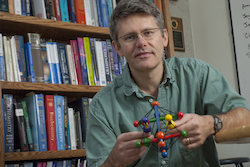Indiana University researchers have developed a highly efficient biomaterial that catalyzes the formation of hydrogen by splitting H2O and creating hydrogen and oxygen. The resulting fuel can be used to power vehicles that essentially run on water. According to the research team, a modified enzyme gains strength from being protected within the protein shell — or “capsid” — of a bacterial virus. This new material, called hydrogenase, is 150 times more efficient than the unaltered form of the enzyme. The process of creating the material was recently reported in “Self-assembling biomolecular catalysts for hydrogen production,” in the journal Nature Chemistry.
“Essentially, we’ve taken a virus’s ability to self-assemble myriad genetic building blocks and incorporated a very fragile and sensitive enzyme with the remarkable property of taking in protons and spitting out hydrogen gas,” explained research lead Trevor Douglas, the Earl Blough Professor of Chemistry in the Indiana University Bloomington College of Arts and Sciences’ Department of Chemistry. “The end result is a virus-like particle that behaves the same as a highly sophisticated material that catalyzes the production of hydrogen.”
The biomaterial created through the process, known as P22-Hyd, is produced through a simple fermentation process at room temperature and is more efficient than the unaltered enzyme. In addition, the biomaterial is potentially less expensive and more sustainable to produce than materials, such as platinum, currently being used to create fuel cells.
“This material is comparable to platinum, except it’s truly renewable,” Douglas said. “You don’t need to mine it; you can create it at room temperature on a massive scale using fermentation technology; it’s biodegradable. It’s a very green process to make a very high-end sustainable material.”Read More







